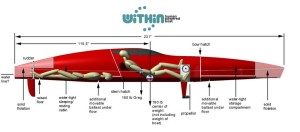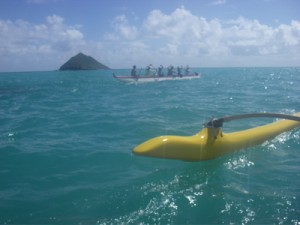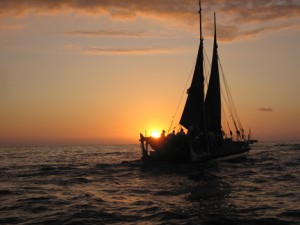
Did you know that the average American watches 2 hours of TV a day? If they went out for a bike ride instead, they would lose 10 pounds in a month.
This is one of the blip-facts available on the website of a fellow adventurer who is pushing the boundaries. Greg Kolodziejzyk is preparing for his 2008 bid to cross the Atlantic ocean in less than 40 days, which would be a new world record for the fastest human powered Atlantic crossing. He is using his project as a platform to show children what the human body is capable of and inspire them to get out and get physical.
Greg is looking for support for his venture - you can join the PedalTheOcean team and be part of a history making human powered world record. The "Across With Greg" sponsorships start at only $30 and include your name on the expedition boat. $100 packages include your name on the boat, your choice of a wide selection of our "human power" line of branded products, and 10% donation to KidPower, which is is a national education program focused on developing young children into healthy, active and positive people.
I should declare a vested interest in supporting Greg in his endeavours - I owe him a debt of gratitude. I had planned to visit him and his wife in Calgary and take a look at his boat (although the word 'boat' hardly seems adequate to describe such a futuristic craft), but unfortunately visa issues forced me to cancel my trip.
So as a consolation, Greg offered to let me stay in their ski lodge in Whitefish, Montana, for a few days. I arrived yesterday in this beautiful part of the world, after a stunningly scenic drive from Mount Rainier in Washington, where I had spent the weekend clambering around with some friends. I am now comfortably ensconced in the lodge, high up on Big Mountain. It will be a real treat to spend more than one night in one place so I can focus on some increasingly pressing tasks connected with the Pacific documentary - of which more news soon.
|
|
You might be interested to see this short video that was created for my presentation to the Brocade worldwide sales team (all 900 of them) a couple of weeks ago. It opens with a scene of me looking very weatherbeaten but very happy out on the Atlantic, and goes on to give an overview of what I've done, and why, and what my plans are for the future.
Click here to view the video.
Thanks for all the suggestions arriving in response to my appeal for information from teachers and students about environmental education. Keep them coming!
|
|

I am in the process of developing a new section of this website specially dedicated to school students and teachers. It will include suggestions for lesson plans, discussion topics and practical projects. Over the coming months I will be working with a few selected teachers from various schools across the world, but initially want to put out these questions to anybody reading this site, but especially school students:
- Do you have any lessons about the environment? If so, what environmental subjects do you learn about? e.g. Climate change? GMO? Ocean conservation? Anything else?
- Do the lessons say anything about how humans affect the environment, and how it affects us? What do the lessons say about interaction between man and the world?
- Do you have any school projects linked to looking after the environment in a hands-on kind of way? e.g. local conservation projects, or litter clean-ups?
It would be really helpful if you can write to me with your answers using the Contact form. This information will be invaluable to me in finding out more about what is happening in environmental education at the moment, and maybe spark off some ideas about what would be helpful for the future.
This is your chance to contribute not only to my website, but also to an education program that will be used by schools all over the world. Thank you!
P.S. Apologies for not blogging for several days. My plane did not fall out of the sky on the way back from Hawaii, and I am still very much alive, just a) very busy and b) frequently offline and c) not wanting to bore you with too much information about daily happenings which, although very important to my overall project direction, may not be of immediate interest to you.
If you REALLY want to know, I've had lots of useful meetings (notably with NOAA, BEACH, and various individuals both in Hawaii and Seattle), given a successful presentation at the wonderfully welcoming Waikiki Yacht Club, went paddling with Donna of nonprofit Kai Makana, and made an appearance on the KHON TV Morning Show in Honolulu.
|
|

... the crew of the Hokule'a would not be the slightest bit bothered. This traditional canoe recently voyaged to Micronesia, Satwal and Japan, relying on traditional wayfinding methods using the stars, ocean swells, cloud formations and bird sightings to reach their destinations.
[Click here for video]
This morning I went to meet a student of this ancient art and take a look around the canoe. Ka'iulani Murphy showed me the vessel that was their home for 5 months earlier this year. The first thing I noticed was the construction - not a nut or a bolt in sight, just lots of rope lashings.
The second thing was that there is no real "below decks" area - from the central deck there are just canvas screens that unzip to reveal long rows of bunks, end to end, along the lines of the two pontoons of the double-hulled canoe.
The canoe looks very seaworthy, but not very comfortable - a bit like my boat, really.
Ka'iulani told me that, even though she has been studying wayfinding for over 7 years now, she is still learning. Not all the skills can be learned from books - the subtleties of sensing changes in direction of wind or swells have to be experienced to be fully understood.
My interest had initially been to find out more about wayfinding - I am interested in it from a very practical point of view for my own voyages (just in case), but also as an example of a traditional wisdom that is now being successfully revived and passed on to a new generation. There are countless other examples of native skills that worked well for centuries but have unfortunately now died out forever, obliterated by the world of technology, so it was encouraging to find a success story.
We found lots more to talk about as well, including the concept of malama honua. This Hawaiian expression means "caring for our world", but it has broader and deeper implications too. Like gaia, it recognizes that the health of the land, the health of the oceans, and the health of all living creatures, including us, are inextricably linked. If one part of the organism is sick, then the other parts will be affected too.
This brings me back to my mission for the first part of my Pacific row - to draw attention to the problem of plastic debris in the oceans, and to emphasize that it is not just a problem "out there". I am looking into how I can develop an educational section on my website that will build on existing online resources to create discussion topics for schools to bring these issues into the classroom. And I also intend that next year, when I am in Hawaii for a bit longer, I can get involved in a very hands-on way, with beach clean-ups and the like. This way, I will be involved in both prevention AND cure.
[photo: Hokule'a, courtesy of Polynesian Voyaging Society website]
|
|